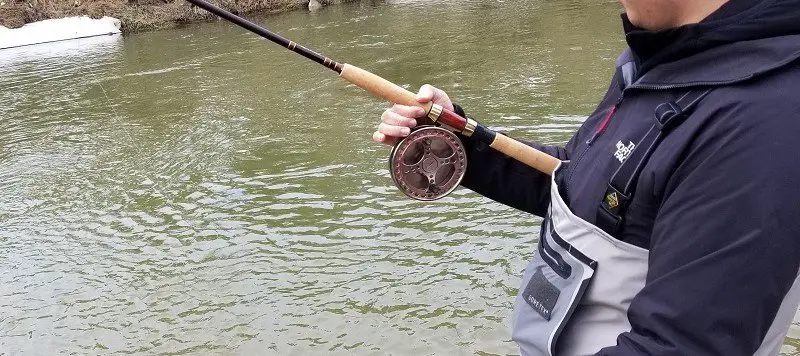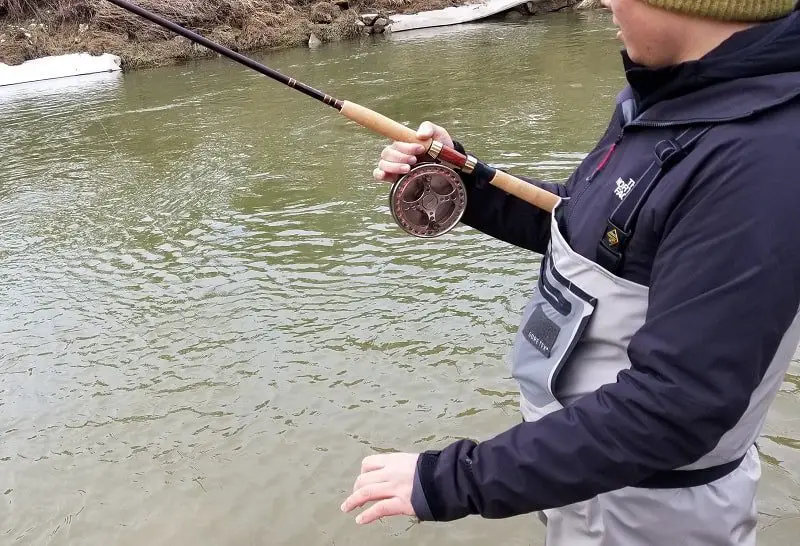How To Cast A Centerpin Reel: The 4 Best Casts
I have taught thousands of anglers how to cast a Centerpin reel during guide trips and in my Centerpin fishing Classes. These are my recommendations and tips on casting a Centerpin reel better, and which Centerpin casts are best for you.
There are three main casts that I recommend to guys learning to cast a Centerpin reel. The Side Cast is often the easiest Centerpin reel cast, but many hardcore Centerpin anglers prefer the Wallace Cast or the spinning Side cast.
All are good ways to cast a Centerpin reel.
Before You Cast A Centerpin Reel

The first thing you need to know before you start casting a Centerpin reel is how to hold the reel in a way that makes it easy and comfortable to hold while still being able to cast the reel and controlling the line and spool speed as well as setting the hook and fighting the fish.
For more detailed information on how to hold a Centerpin reel, check out my page How To Hold A Centerpin Reel: 4 Ways That Work Well.
How Far Can You Cast A Centerpin Reel?
With a heavy-weighted float and leader, you can cast a Centerpin reel over 100 feet. If you fish with less weight, a typical casting distance is around 60 feet. Most anglers won’t need to cast further than 50 feet.
The three best casts that I talk about below are the best casts for distance and accuracy.
The Side Cast
The first cast is called the Side Cast and is the one I teach most new anglers because it is the easiest to learn. When I’m guiding, I would rather focus on teaching anglers how to fish and catch fish all day and not need to worry about them struggling with casting all day. This cast is used by many very good anglers that I have guided.
The advantage of the side cast is that it is easy, accurate, and casts far.
The disadvantage to the side cast is that if your hands are wet from rain, the line can get sticky and make it difficult to cast.
Another disadvantage of the side cast is that it’s also very common to get line twist which can eventually cause problems with the line flowing through the guides or getting wrapped around your rod tip.
However, there is a quick fix for line twists that most anglers don’t know about, and this tip will prevent you from needing to cut off your line and putting a new line on, which gets expensive.
The simple trick is to fish until the twist in the line gets too bad and then cut your mainline about 2 to 5 feet above the float and put in a micro swivel there. Then make a few long drifts, and often the twist will come out.
Some anglers even use 3x-small swivels 5 feet up above the float all the time, and they never get line twists. Some of my best clients use this method and they never get a line twist.

With the side cast, you simply pull the line off the side of the reel with one hand, swing the rod, and let the line come off the side of the reel to your hand and out toward the fish.
I will include a link to a video of this below.
The Spinning Side Cast
The spinning side cast is a combination of the side cast and the Wallace cast below. In this cast, you will slowly spin the reel and perform the side cast at the same time. It’s easy, and it takes some of the twist out of the line that can occur with the regular side cast.
The Wallace Cast
The second best cast I recommend is called the Wallace Cast, which is harder to learn but it’s possibly the best cast if you learn it well. The advantage of the Wallace Cast is long accurate casts with no line twist.
You will also have no problems with sticky, wet hands when using the Wallace cast.
The downside of the Wallace cast is that it is hard to use and I do not recommend it for beginners.
I never teach the Wallace cast to beginners because I would rather spend all day teaching anglers how to fish effectively with a Centerpin than spend all day trying to wait for them to get the Wallace cast right.
The Wallace Cast takes practice and there is timing and coordination required, which is not what you want to be trying to figure out on a guide trip.
With the Wallace cast, you simply pull the line down and start the reel spinning at the same time that you cast the rod forward. If you pull too fast, the line will over-spool and could leave you with a bird’s nest knot. If you pull too slow, it won’t go far.
The farther your cast, the faster you must pull the line and spin the spool. This makes it difficult for many beginners.
I recommend using the Side cast first, getting good at fishing with a Centerpin, and learning the four fundamentals of Centerpin fishing. Once you are good at fishing and are no longer struggling with the basics, then start learning how to do the Wallace cast.
If you are not sure what the four fundamentals of good float fishing are, check out my page Centerpin Fishing For Beginners: 20 Steps From A Top Guide.
I will provide a link to a video on how to do the Wallace Cast below.
The Drop Line Cast
The Drop Line cast is for those anglers who struggle with the Side Casts or the Wallace cast. It’s a last resort type of cast simply because it can cause some serious tangles, and the other casts are just better
With this cast, you grab the line and pinch it against the rod and your rod hand and then let 10 to 40 feet of line drop off the reel to the ground or water by your feet with the other hand.
You then swing and cast the rod and release the line from your rod hand. I don’t recommend this cast.
The BC Swing Cast
I never use the BC swing cast, but I hear from guide friends out west that it works well on the bigger rivers where they use large floats with lots of weights and big baits.
If you fish huge rivers, this cast might be the best cast for you.
Watch this video on How To Do The BC Swing Cast to see this cast in action and learn how to do it well.
Other Centerpin Casts
There are a few other Centerpin casts that I have seen anglers do, and I will be blunt and honest by saying they all suck and you should just ignore them all.
How To Cast A Centerpin Reel Video
It’s hard to explain Centerpin casting, so see how to do the two casts that I recommend On YouTube HERE.
Tight Lines
Graham
